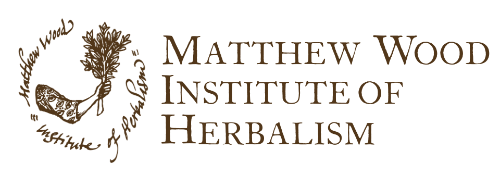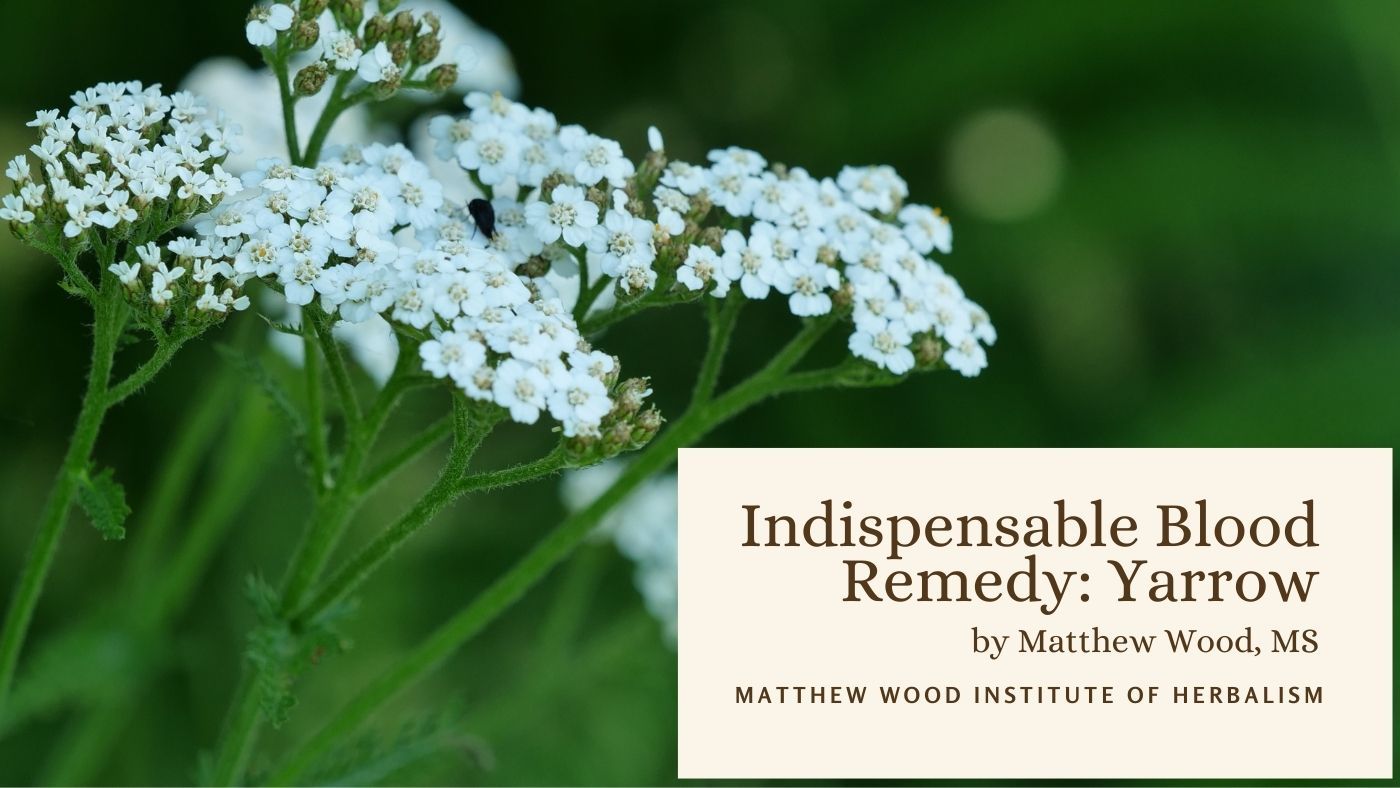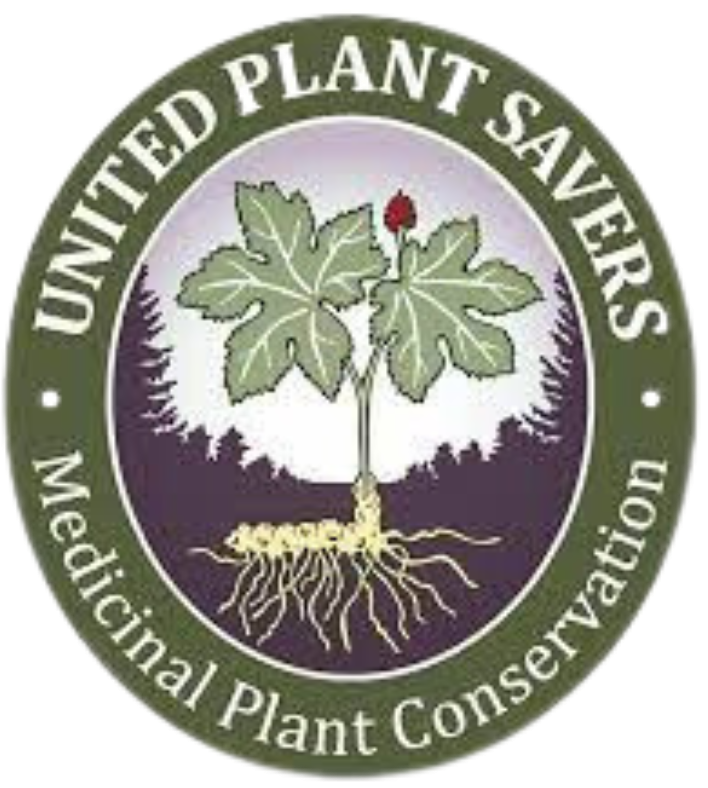I. The Indispensable Blood Remedy.
In order to effectively remedy disease we have to be able to decongest blood associated with inflammation, thin stagnant, congealed blood, tone the veins, stimulant the capillaries and arteries, and move the blood to or from the surface. Yarrow, the great ‘normalizer’ of the blood does all these things.
Achillea millefolium. Yarrow.
Yarrow is a member of the aster family native to Europe and Asia. A similar species, Achillea lanulosa, grown in North America, can only be differentiated under the microscope. It is indistinguishable in the field from the Old World species and used interchangeably. The pharmacological constituents of achillea are numerous and complex. The leaves and flowers contain flavonoids, vitamin C, bitters, tannins, alkaloids, sterols, phenolic acids (including salicylate), coumarins, sesquiterpine lactones (including achillin), volatile oils (including the toxic thujone irritating borneal, stimulating camphor, antiseptic pinenes, etc.), and many other constituents.
Yarrow is one of the primal remedies of the Western herbal tradition. It can be called the ‘master of the blood.’ Through numerous devices – clotting, unclotting, neurovascular control, flavonoids, etc. – it regulates the flow of blood to and from the surface, in and out of the capillaries and venules, thickening and thinning. Through this, it remedies all manner of wounds, bruises, hemorrhaging, and clotting. The same property, combined with its diaphoretic capacity, makes it a ‘master of fever,’ moving blood to or from the surface to release or preserve heat and regulate fluids. Although pungent, bitter, and astringent in taste, it also contains high levels of flavonoids, which sooth the capillaries so the blood passes quicker. Thus, it is both cooling and warming, fluid generating and controlling. Remedies with contradictory but complementary properties are often of great utility since they are able to normalize opposing conditions. This is true for yarrow.
Through its action on the blood and vasculature yarrow is suited to, (1) lacerations, bruises, active hemorrhaging, and old, hardened bruises, (2) fevers, or fevers and chills, (3) heat and congestion in the digestive tract, portal vein, liver, and abdominal viscera, and (4) uterine congestion with excessive (or lack of) bleeding. Yarrow can be useful in almost any kind of acute inflammation with congestion of blood. It is specific for hemorrhages with bright, red bleeding and contraindicated in passive, dark, coagulated flow (cf. shepherd’s purse).
In addition to the evidence of heat there is usually signs of stagnant blood. Together, these give rise to characteristic pink/red and blue coloration. Yarrow is almost always indicated by an elongated, pointed, reddish tongue (the classic indication for heat), but with a blue undertone or middle, indicating venous stagnation. The tongue is usually dry in the center, indicating that heat is driving off fluids. There may be a crack down the mid line; in severe cases it opens up to reveal a deeper layer of tissue which is dark and crisscrossed by lines (chained or feathered). This is an indication that heat is burning deep into the tissues, especially of the digestive tract, or that the spine is inflamed. The pulse is usually rapid, full, and nonresistant, showing that heat is having its way with the tissues. The complexion is often reddish with blue veins (tongue and pulse indications from William LeSassier and Matthew Wood).
There are other cases, however, where yarrow is suited to a pale and dry tongue. As a bitter it increases secretion in the digestion tract and, with its ability to decongest the internal organs when blood is collecting in the interior, it brings blood to the surface and improves digestion and assimilation. It can provoke menses by bringing the blood to the surface just as it can curtail them when excessive. Likewise, it can provoke diaphoresis when the skin is in an atonic, weak condition.
In addition to its action as a hemostatic or normalizer of the blood and circulation, yarrow also acts on the skin as a diaphoretic and on the kidneys as a diuretic. Thus, it normalizes the distribution, secretion, and elimination of water in the body. A hot or warm cup of yarrow tea will open the skin, while a cold cup tends to stimulate the stomach, digestion, and kidneys. The influence of yarrow can also be changed and directed according to whether it is used fresh or dry or how long it is decocted or infused, since certain constituents come out at different temperatures and periods of extraction. Not all these preparation differentials are understood.
Taste: bitter, pungent, acrid, diffusive, astringent, aromatic
Tissue State: excitation, depression, relaxation
Specific Indications
Constitution, Complexion, Characteristic Symptoms
Mind, Senses, Nerves, Emotions, Personality
Head
Digestive
Liver
Female
Kidneys and Bladder
Muscular and Skeletal
Circulation and Blood
Fever
Wounds
Other
Preparation and dosage:
“The whole plant is used fresh gathered, but the best part is the tops,” comments the eminent John Hill (1740, 392). The flower tops are harvested at their peak and dried for use as a tea or tinctured fresh in alcohol. The young leaves and roots may also be used. The situation, soil, and exposure to the sun changes the properties somewhat. Infusion: 1 tsp to a cup of boiling water, cover to preserve oils, steep for 13 minutes (Harald Tietze, 1996, 47). Letting it stand longer can change the properties (Eva Graf). Dosage: 1-3x/day in chronic conditions; hourly in fevers. Tincture: 5-20 drops is a usual dose (Fyfe), 15-30 drops (Gagnon), 20-40 drops (Hoffmann). I use yarrow in 1-3 drops, 1-3x/day. A cup of the hot tea works better for pale skin with blood stuck in the interior.
Cautions:
Allergies to yarrow are possible. It should not be taken in large doses during pregnancy, but it is sometimes appropriate in small doses at that time.
Looking to learn more about topics in this blog? Check out these great A-Z Herbal Classes.
"In a busy practice covering over twenty-five years and tens of thousands of clients, a person learns what remedies are of invaluable service. I would like to share my selection – herbs I choose and herbs that choose me."
Achillea millefolium. Yarrow.
Yarrow is a member of the aster family native to Europe and Asia. A similar species, Achillea lanulosa, grown in North America, can only be differentiated under the microscope. It is indistinguishable in the field from the Old World species and used interchangeably. The pharmacological constituents of achillea are numerous and complex. The leaves and flowers contain flavonoids, vitamin C, bitters, tannins, alkaloids, sterols, phenolic acids (including salicylate), coumarins, sesquiterpine lactones (including achillin), volatile oils (including the toxic thujone irritating borneal, stimulating camphor, antiseptic pinenes, etc.), and many other constituents.
Yarrow is one of the primal remedies of the Western herbal tradition. It can be called the ‘master of the blood.’ Through numerous devices – clotting, unclotting, neurovascular control, flavonoids, etc. – it regulates the flow of blood to and from the surface, in and out of the capillaries and venules, thickening and thinning. Through this, it remedies all manner of wounds, bruises, hemorrhaging, and clotting. The same property, combined with its diaphoretic capacity, makes it a ‘master of fever,’ moving blood to or from the surface to release or preserve heat and regulate fluids. Although pungent, bitter, and astringent in taste, it also contains high levels of flavonoids, which sooth the capillaries so the blood passes quicker. Thus, it is both cooling and warming, fluid generating and controlling. Remedies with contradictory but complementary properties are often of great utility since they are able to normalize opposing conditions. This is true for yarrow.
Through its action on the blood and vasculature yarrow is suited to, (1) lacerations, bruises, active hemorrhaging, and old, hardened bruises, (2) fevers, or fevers and chills, (3) heat and congestion in the digestive tract, portal vein, liver, and abdominal viscera, and (4) uterine congestion with excessive (or lack of) bleeding. Yarrow can be useful in almost any kind of acute inflammation with congestion of blood. It is specific for hemorrhages with bright, red bleeding and contraindicated in passive, dark, coagulated flow (cf. shepherd’s purse).
In addition to the evidence of heat there is usually signs of stagnant blood. Together, these give rise to characteristic pink/red and blue coloration. Yarrow is almost always indicated by an elongated, pointed, reddish tongue (the classic indication for heat), but with a blue undertone or middle, indicating venous stagnation. The tongue is usually dry in the center, indicating that heat is driving off fluids. There may be a crack down the mid line; in severe cases it opens up to reveal a deeper layer of tissue which is dark and crisscrossed by lines (chained or feathered). This is an indication that heat is burning deep into the tissues, especially of the digestive tract, or that the spine is inflamed. The pulse is usually rapid, full, and nonresistant, showing that heat is having its way with the tissues. The complexion is often reddish with blue veins (tongue and pulse indications from William LeSassier and Matthew Wood).
There are other cases, however, where yarrow is suited to a pale and dry tongue. As a bitter it increases secretion in the digestion tract and, with its ability to decongest the internal organs when blood is collecting in the interior, it brings blood to the surface and improves digestion and assimilation. It can provoke menses by bringing the blood to the surface just as it can curtail them when excessive. Likewise, it can provoke diaphoresis when the skin is in an atonic, weak condition.
In addition to its action as a hemostatic or normalizer of the blood and circulation, yarrow also acts on the skin as a diaphoretic and on the kidneys as a diuretic. Thus, it normalizes the distribution, secretion, and elimination of water in the body. A hot or warm cup of yarrow tea will open the skin, while a cold cup tends to stimulate the stomach, digestion, and kidneys. The influence of yarrow can also be changed and directed according to whether it is used fresh or dry or how long it is decocted or infused, since certain constituents come out at different temperatures and periods of extraction. Not all these preparation differentials are understood.
Taste: bitter, pungent, acrid, diffusive, astringent, aromatic
Tissue State: excitation, depression, relaxation
Specific Indications
Constitution, Complexion, Characteristic Symptoms
- Robust, sanguine persons, with red, full-blooded complexion; and sensitive persons, easily hurt.
- Complexion of skin red with blue veins showing through on the arms and legs; bruises are red and blue.
- Tongue elongated, pointed, red, blue in the center; dry towards the center, not heavily coated, wet towards the edges.
- Tongue cracked down the middle and opening up to reveal crisscrossed, red tissues ("chaining" or "feathering)
- looks like a feather or a yarrow leaf); this indicating "heat attacking the blood level."
- Tongue; purple line anywhere.
Mind, Senses, Nerves, Emotions, Personality
- The “wounded warrior, wounded healer” remedy; “people that jump in, put out the fires, get cut to the bone, emotionally and physically;” sensitive, delicate persons, easily hurt (Barbara St. Dennis).
Head
- Congestion of blood to the head; headache, vertigo, nosebleed, high blood pressure; in red, robust, sanguine persons, or during fever.
- Nosebleed.
- Earache, toothache, gingivitis.Respiratory System– Stuffed sinuses (vapor, warm tea, tincture).
- Bronchitis, pleurisy, pneumonia; inflammation and pain in the chest; bleeding from the lungs with night sweats.
- Palliative in the bleeding and night sweats of tuberculosis (cold infusion).
Digestive
- Lack of appetite, bloating, digestive cramps, colic.– Dyspepsia, colitis, diverticulitis, bleeding hemorrhoids; tongue red and cracked down the middle; with rapid, full, nonresistant pulse.
- Diarrhea in infants.
- Bleeding from the stomach or intestines.
- Bleeding hemorrhoids (cf. Bidens, Rumex crispus).
Liver
- Liver inflammation, acute hepatitis (external, warm compress, once a day).
Female
- Lack of menstrual flow, difficult to start (drink a cup a day or two warm cups before); or, heavy, hemorrhagic flow, hard to stop, excessive bleeding.
- Clumsy feeling just before the onset of the period.
- Menstrual cramping.
- Endometriosis (cf. Trillium).
- Uterine fibroids; with bright red hemorrhage (cf. Capsella, fibroids, clotted, dark flow) (bath).
- Inflammation of the ovaries.
- Vaginal discharge.
- Uterine prolapse.
- Menopause: restlessness; night sweats.
- Pregnancy: morning sickness, restlessness, heat (but caution during pregnancy).
- Parturition: clumsiness twelve hours before delivery due to hormonal changes loosening the tendons; to prevent excessive bleeding and pain.
- Parturition: pain after delivery, suppression of the lochia.
- Lactation: sore nipples.
Kidneys and Bladder
- Nephritis; acute inflammation and bleeding from the kidneys.
- Acute cystitis; with or without bleeding; with mucoid discharges; scanty urine, also incontinence; irritative conditions of the urinary apparatus, strangury, and suppression of urine (infusion).
Muscular and Skeletal
- Arthritis, gout, rheumatism.
Circulation and Blood
- Varicose veins (bath).
- High blood pressure where there is blood congestion.
Fever
- In acute fever, pulse rapid, full, nonresistant.
- Fever; sudden onset, in robust persons, with or without chills
- Fever; chicken pox, measles; brings out rash.
- Acute fever, early stages; skin cool, pulse weak, brings circulation to the surface and brings out the rash (hot infusion).
Wounds
- Lacerations; injuries to the arteries, of violent origin; hemorrhage, of bright red arterial blood; tenderness and oversensitivity in wounds.
- Bruises of violent origin; with cuts (cf. Arnica, bruises without cuts or bleeding); blood blisters.
- Old bruises that have become hard; especially on the head.
- Stroke, head injury, hematoma (external).
- Cerebral thrombosis.
- Psoriasis (bath).
- Pale, thin skin with poor circulation to the periphery and closed pores (infusion of the flower/herb).
- Bee sting (external).
- Wrinkles (external).
Other
- Fistulae.
- Reported antidote to radiation (cf. Larrea).
- Environmental allergies; cools heat and reduces sensitivity
Preparation and dosage:
“The whole plant is used fresh gathered, but the best part is the tops,” comments the eminent John Hill (1740, 392). The flower tops are harvested at their peak and dried for use as a tea or tinctured fresh in alcohol. The young leaves and roots may also be used. The situation, soil, and exposure to the sun changes the properties somewhat. Infusion: 1 tsp to a cup of boiling water, cover to preserve oils, steep for 13 minutes (Harald Tietze, 1996, 47). Letting it stand longer can change the properties (Eva Graf). Dosage: 1-3x/day in chronic conditions; hourly in fevers. Tincture: 5-20 drops is a usual dose (Fyfe), 15-30 drops (Gagnon), 20-40 drops (Hoffmann). I use yarrow in 1-3 drops, 1-3x/day. A cup of the hot tea works better for pale skin with blood stuck in the interior.
Cautions:
Allergies to yarrow are possible. It should not be taken in large doses during pregnancy, but it is sometimes appropriate in small doses at that time.
Looking to learn more about topics in this blog? Check out these great A-Z Herbal Classes.
"In a busy practice covering over twenty-five years and tens of thousands of clients, a person learns what remedies are of invaluable service. I would like to share my selection – herbs I choose and herbs that choose me."
References
Traditional (8, 12, 14, 16, 22, 24, 25, 26, 36-42), Linneus (7), Maria Treben (19, 21, 23, 27, 35), Barbara St. Dennis (1, 6), William LeSassier (3-5), Matthew Wood (1, 2-5., 7, 20, 28, 33, 35, 43, 44), E. B. Nash (12), Jack Ritchason (15), Nicholas Culpeper (17), Richard Hool (17), Otto Wolff (18), Flower Essence Society (1, 6, 51), Christopher Menzies-Trull (44-6), Margi Flint (47), Julia Graves (13), Wendy Fogg (29), Robert Dale Rogers (9, 10, 22, 24, 25, 30, 31, 32, 48, 49), David Hoffmann, John Christopher (7, 13, 14, 17, 19, 31, 32, 33, 34, 50), John William Fyfe (11, 17, 19, 25, 30, 32, 33). An extensive account is given in Matthew Wood, The Book of Herbal Wisdom.
Selections from The Earthwise Herbal By Matthew Wood, MS Published by North Atlantic Books, in two volumes, 2008-9
Traditional (8, 12, 14, 16, 22, 24, 25, 26, 36-42), Linneus (7), Maria Treben (19, 21, 23, 27, 35), Barbara St. Dennis (1, 6), William LeSassier (3-5), Matthew Wood (1, 2-5., 7, 20, 28, 33, 35, 43, 44), E. B. Nash (12), Jack Ritchason (15), Nicholas Culpeper (17), Richard Hool (17), Otto Wolff (18), Flower Essence Society (1, 6, 51), Christopher Menzies-Trull (44-6), Margi Flint (47), Julia Graves (13), Wendy Fogg (29), Robert Dale Rogers (9, 10, 22, 24, 25, 30, 31, 32, 48, 49), David Hoffmann, John Christopher (7, 13, 14, 17, 19, 31, 32, 33, 34, 50), John William Fyfe (11, 17, 19, 25, 30, 32, 33). An extensive account is given in Matthew Wood, The Book of Herbal Wisdom.
Selections from The Earthwise Herbal By Matthew Wood, MS Published by North Atlantic Books, in two volumes, 2008-9
**Disclaimer**
The information provided in this digital content is not medical advice, nor should it be taken or applied as a replacement for medical advice. Matthew Wood, the Matthew Wood Institute of Herbalism, ETS Productions, and their employees, guests, and affiliates assume no liability for the application of the information discussed.
The information provided in this digital content is not medical advice, nor should it be taken or applied as a replacement for medical advice. Matthew Wood, the Matthew Wood Institute of Herbalism, ETS Productions, and their employees, guests, and affiliates assume no liability for the application of the information discussed.


